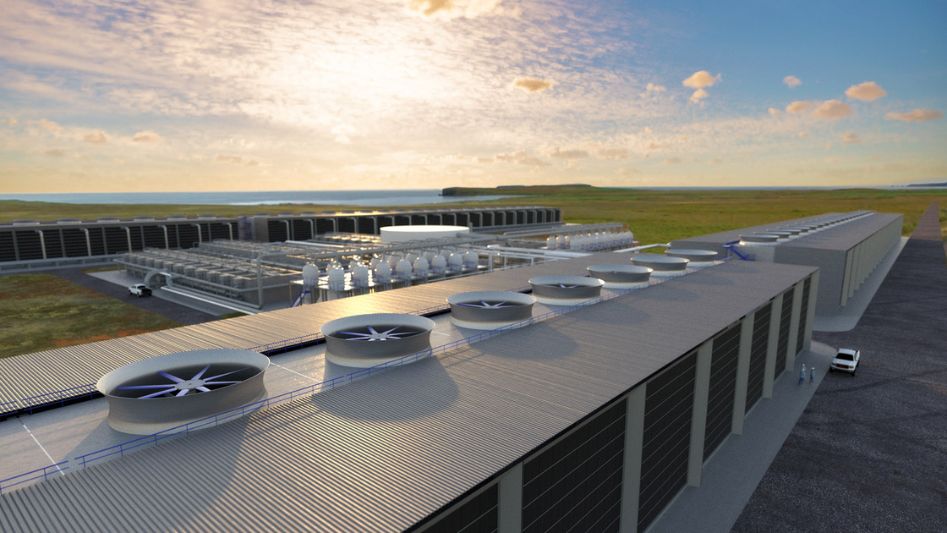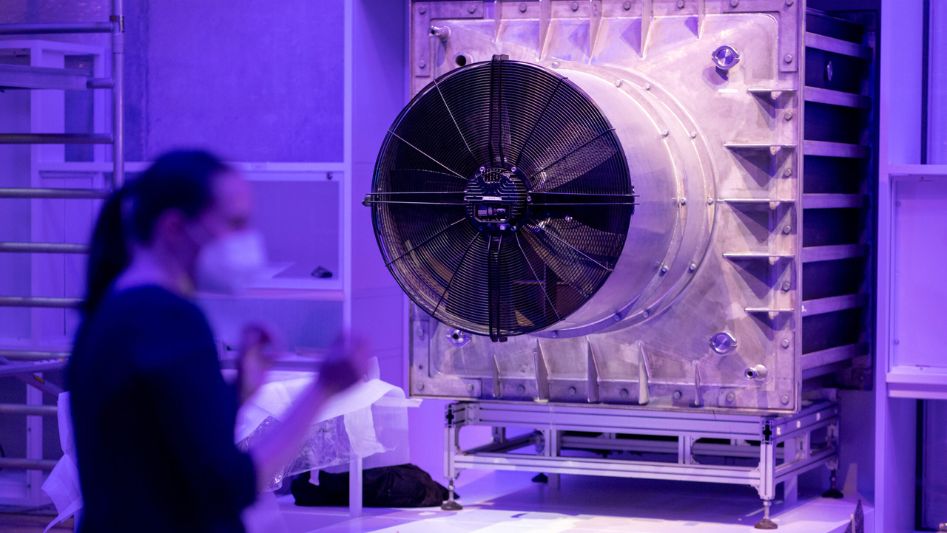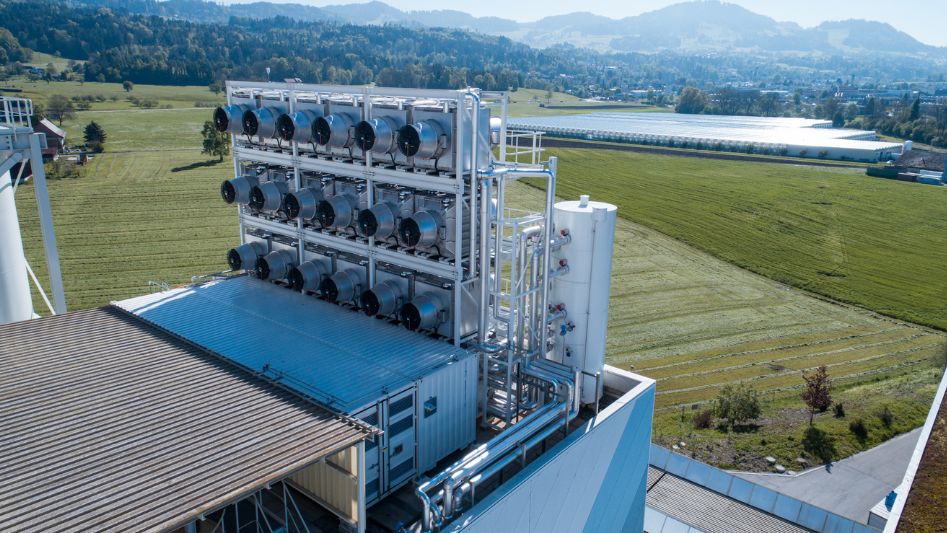Direct air capture (DAC) is a technology that draws carbon dioxide out of the atmosphere to produce safe, reliable and sustainable “green” fuel.
Table Of Content
- Introduction
- What is the amount of CO2 in the atmosphere?
- What Is the Process of Direct Air Capture?
- Direct Air Capture vs. Carbon Capture and Storage
- Carbon Capture to Fight Climate Change
- Current DAC Initiatives and Results
- Advantages and disadvantages
- Conclusion
- FAQ
- You May Also Like
- External Links
In direct air capture, atmospheric air is sucked in and the carbon dioxide (CO2) gas is extracted by chemical processes. The stored CO2 may be utilized in the production of cement and polymers, or it can be buried for future use. Direct air capture is an attempted technical solution to lowering atmospheric CO2 levels. This would allow direct air capture to complement existing efforts to lessen the climate crisis’s potentially disastrous consequences.

The International Energy Agency, a group that models energy use, reports that there are 15 direct air capture facilities in operation in the United States, Europe, and Canada. More than nine thousand metric tons of carbon dioxide are removed annually by these plants. The United States is also working on building a direct air capture facility that can pull one million tons of CO2 annually from the atmosphere.
To prevent CO2 levels in the atmosphere from exceeding 440 parts per million by volume and global temperatures from rising more than 2 degrees Celsius, the U.N.’s Intergovernmental Panel on Climate Change (IPCC) has warned that global CO2 emissions need to be reduced by 30% to 85% before the year 2050 (3.6 degrees Fahrenheit). Is it possible that these losses might be mitigated by using direct air capture?
International Panel on Climate Change (IPCC) scientists and economists believe that long-term actions are required to limit the quantity of human-made greenhouse gas emissions in order to prevent the course of climate change. As a standalone strategy, direct air capture has been criticized for not being effective enough to reduce hazardous CO2 levels in the atmosphere. Additionally, the cost per ton of CO2 gathered is higher than with other methods of dealing with the climate challenge.
What is the amount of CO2 in the atmosphere?
- About 0.04% of the air we breathe is carbon dioxide. This increasing concentration is particularly worrisome because of its capacity to trap heat.
- Since 1958, scientists from UC San Diego’s Scripps Institution of Oceanography have been monitoring atmospheric CO2 levels at the Mauna Loa observatory in Hawaii. Atmospheric carbon dioxide concentrations were below 320 ppm and growing at a rate of around 0.8 ppm per year. In the last decade, the pace of rise has quickened to a concerning 2.4 ppm each year.
- CO2 levels reached a maximum of 417.1 parts per million in May 2020, the highest seasonal peak in 61 years of records, as reported by the Scripps Institution of Oceanography.
What Is the Process of Direct Air Capture?
There are two methods for direct air capture that are used to get rid of CO2 in the air. In the first method, a solid sorbent is used to absorb the carbon dioxide. A solid sorbent is a substance that is applied to the surface of another solid substance. Through a chemical process initiated by the passage of air over the solid sorbent, carbon dioxide (CO2) gas is bound to the basic sorbent. To remove the CO2 from the solid sorbent, it is either heated to between 80 and 120 degrees Celsius (176 and 248 degrees Fahrenheit) or placed under a vacuum. 7 Once the sorbent has cooled, it may be reused.
The alternative direct air capture approach is more involved since it requires the use of a liquid solvent. A liquid solution of potassium hydroxide (KOH) is first allowed to flow over a plastic surface in a big container. Huge fans draw air into the container, and when the CO2-laden air meets the liquid, a carbon-rich salt is produced.
At this point, the salt enters a second chamber where a chemical reaction takes place, resulting in a slurry of water and solid calcium carbonate (CaCO3) pellets (H2O). After combining calcium carbonate with water, the solution is filtered to separate the two components. At this point, the solid calcium carbonate pellets are heated to 900 degrees Celsius (1,652 degrees Fahrenheit) using natural gasalcium carbonate (CaCO3) pellets (H2O). After combining calcium carbonate with water, the solution is filtered to separate the two components. At this point, the solid calcium carbonate pellets are heated to 900 degrees Celsius (1,652 degrees Fahrenheit) using natural gas. The resulting CO2 gas is ultra-pure and may be easily collected and compressed.
In order to reuse the surplus resources, they are recycled back into the system. Captured carbon dioxide (CO2) may be used to make long-lasting goods like polymers and building materials, or it can be permanently pumped underground into rock formations to revitalize dormant oil wells.
Direct Air Capture vs. Carbon Capture and Storage
Direct air capture and carbon capture and storage (CCS) are two methods often cited as crucial to addressing the climate catastrophe. Both methods have the potential to decrease CO2 emissions into the air. When capturing carbon dioxide (CO2), CCS employs a chemical rather than a vacuum to collect the gas at the point of emission. Because of this, no carbon dioxide will ever be released into the air. The CO2 in the emissions of a coal-fired power plant’s stack, for instance, might be captured and compressed using CCS. Instead, CO2 might be captured after it has already been discharged into the air by a coal-fired power station or other fossil fuel-burning activities using a process called direct air capture.

Carbon Capture to Fight Climate Change
In order to extract CO2 from the air, both direct air capture and CCS rely on simple chemical components like potassium hydroxide and amine solvents. After CO2 is collected, it must be compressed, transported, and stored for further use in either process. Both CCS and direct air capture are promising new technologies, with CCS having a little longer history.
CCS can only be implemented in places where there is fossil fuel burning, such as factories and power plants, where the CO2 is being produced. While direct air collection could theoretically be utilized everywhere, its efficiency would be maximized if it were located near existing power infrastructure or CO2 storage facilities.
Current DAC Initiatives and Results
Climeworks, Global Thermostat, and Carbon Engineering are the top three direct air capture firms in the world, according to the World Resources Institute.
3 Three businesses are involved in CO2 removal, with two using solid sorbent technology and one using liquid solvent carbon engineering. A number of commercial facilities are now under development, and the number of operating and pilot plants varies from year to year, but the first commercial-grade DAC facility in the world currently removes 900 tons of CO2 per year.
A direct air capture pilot plant in Squamish, British Columbia, Canada, has been using renewable energy and natural gas to power a liquid solvent process that removes one ton of CO2 per day from the air for the last 15 years. The same business is also in the process of constructing a second direct air capture plant with the capacity to collect one million tons of carbon dioxide annually.
Forever storing the compressed gas underground, a new direct air capture facility in Iceland will be able to collect 4,000 metric tons of CO2 annually. The business constructing this facility already operates 15 smaller direct air capture facilities in various locations around the globe.
Advantages and disadvantages
As previously mentioned, the most notable benefit of direct air collection is its potential to lower atmospheric CO2 levels. In addition to being more generally applicable than CCS, it also requires less land area to capture the same quantity of carbon as other carbon sequestration methods. Direct air capture may also be utilized to produce synthetic hydrocarbon fuels. However, the technology can only be useful if it can be used in the long run, is affordable, and can be easily scaled. However, direct air collection technology is not yet at the point where it can fulfill these needs.
Pros
Direct air capture technology providers are working on new, bigger direct air capture facilities that can collect up to 1 million tons of CO2 per year. Smaller direct air capture machines have the potential to absorb as much as 10% of the CO2 that humans emit. 2 The carbon dioxide is eliminated from the carbon cycle by being injected and stored underground.
Direct air capture may operate independently of fossil fuel-burning power stations and other facilities since it depends on absorbing CO2 from the atmosphere rather than from direct emissions. Because of this, direct air capture plants may be located anywhere and at any height.
Direct air capture requires less space in which to operate per ton of carbon dioxide captured than other methods.
Further, by mixing collected CO2 with hydrogen to make synthetic fuels like methanol, direct air capture has the potential to lessen our reliance on extracting fossil fuels and our overall contribution to atmospheric CO2 levels.
Cons
Reforestation and afforestation are less costly methods of carbon capture than direct air capture. Estimates for the price per ton of CO2 removed by certain direct air capture facilities range from $100 to $1,000. Future prices of direct air capture are unpredictable since they will depend on how rapidly the technology progresses, according to experts at the RFF-CMCC European Institute on Economics and the Environment. When compared, the cost of reforestation is often less than $50 per ton.
The high cost of direct air capture results from the substantial amount of energy needed to eliminate CO2. It takes a lot of energy to heat the liquid solvent to 900 °C (1,652 °F) and the solid sorbent to 80 °C to 120 °C (176 °F to 248 °F) for direct air capture, respectively. Even if the ultimate result is carbon negative, a direct air capture plant must still consume fossil fuels to get there. This is the case unless the plant employs only renewable energy to generate heat.
Conclusion
It is becoming more apparent from climate models that massive removal of carbon dioxide will be required by mid-century, along with significant reductions in emissions. To achieve national and global climate goals, carbon removal—including DAC—may become increasingly necessary the longer we wait to reduce emissions. To remove huge amounts of carbon at a reasonable cost and without undue danger, a combination of methods is necessary.
FAQ
How can direct air capture fail, and what are the consequences?
The air is difficult to collect because of the low concentration of carbon dioxide (390 ppm). In order to absorb the CO2 at a significant pace, the process requires a large surface area.

Is there a practical use for direct air capture?
Direct air capture has the potential to remove carbon from the atmosphere, making it an effective tool in the fight against carbon emissions that are difficult to prevent (such as those from certain businesses).
What is the price tag on air capture technology?
According to Barbara Truyers, manager for strategic partnerships at Climeworks, the cost of direct air capture, or DAC, technology is expected to drop as low as $250-$300/mtCO2e by the end of this decade for a range of multi-megaton capacities. This was reported to S&P Global Commodity Insights.
You May Also Like
- WHAT IS THE CARBON FOOTPRINT OF A SOLAR PANEL? OVERVIEW AND EMISSIONS
- WHAT IS AN ESG SCORE AND HOW IS IT CALCULATED?
- ESG REPORTING 101: ALL YOU NEED TO KNOW & HOW TO GET STARTED
- THE NEW HYDROGEN PRODUCTION METHOD NO-ONE IS TALKING ABOUT
- SUPER CONCENTRATED SOLAR POWER: THE NEW INVENTION THAT WILL CHANGE THE WORLD
